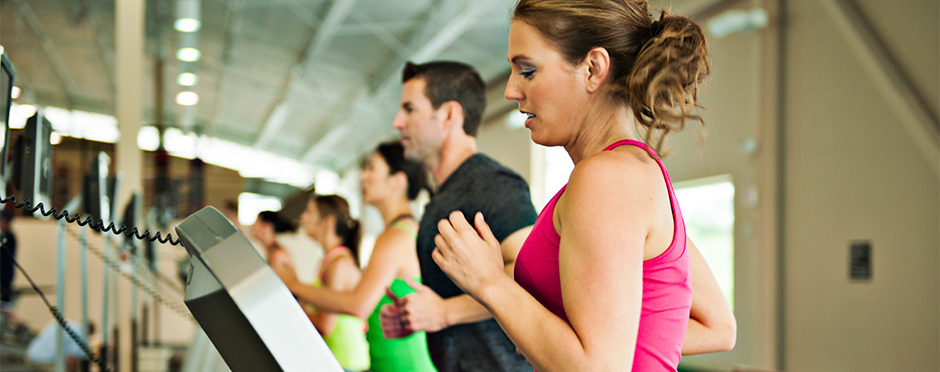
How to Start Exercising for Beginners
Leave a CommentWhen was the last time you worked out? Has it been a few weeks or months? That’s okay! It is never too late to start exercising for the first time, and it’s never too late to get back into exercising after some time away. Read below for some tips on how to get started!
Warm Up
Warming up your body is essential to maintain safety and reduce the risk of injury while exercising. A gradual increase in heart rate allows blood circulation and nutrients to your muscles, tissues and organs. The increased body temperature allows for increased mobility to your joints so that your body is ready for the “main event” of your workout, whatever that might be. All movements should be dynamic, with steady, constant movement requiring the use of multiple muscle groups to encourage increased respiration, increased perspiration and increased heart rate. A well designed warm up will increase muscle temperature, core temperature and blood flow. Some warm up examples include: 5-10 minutes of brisk walking, cycling, jumping jacks, jump rope, walking lunges or squats.
Core Activation
After completion of a warm up, an emphasis on core exercise allows the muscle groups most central to our bodies to be activated. If the core muscles are “activated” you are more likely to utilize these muscle groups during your workout. Our bodies move based on the principle that proximal stability encourages distal mobility. What this means is that in order to have efficient locomotion (movement from one place to another), our bodies require core strength and core stability. The more core stability one’s body holds, the better one’s body is able to produce efficient, quick and safe movements. If your goal is to run, you will need core stability to move your arms and legs. If your goal is to play tennis, you will need core stability to safely stop and pivot to hit the ball. If your goal is to lift weights, you will need core stability to move heavy weight over your head or squat with your legs.
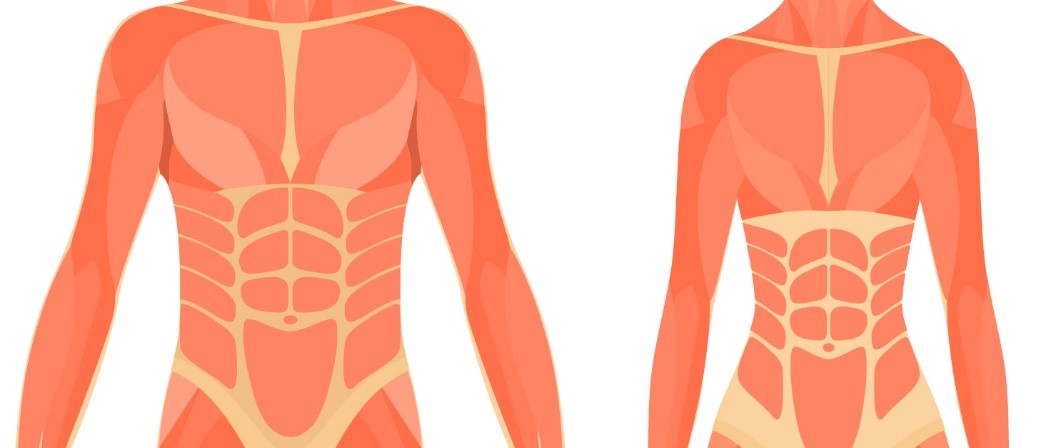 True core activation is difficult because there are so many different advertised ways to activate your core muscles, however not all popular methods activate the most important and deepest layers of our core muscles. Our “core” is the center most part of our physique and it is the location where breathing occurs. In order to best perform “core activation,” the core should be placed in a centrally located position with respect to the arms and legs. Additionally, incorporating breathing during core activation is essential, and will allow the deepest layers of the core to be activated. Below are a few examples of how to “activate the core.”
True core activation is difficult because there are so many different advertised ways to activate your core muscles, however not all popular methods activate the most important and deepest layers of our core muscles. Our “core” is the center most part of our physique and it is the location where breathing occurs. In order to best perform “core activation,” the core should be placed in a centrally located position with respect to the arms and legs. Additionally, incorporating breathing during core activation is essential, and will allow the deepest layers of the core to be activated. Below are a few examples of how to “activate the core.”
1. Primal Plank – Stabilize yourself on your hands and knees with your fingers spread wide, chin tucked, eyes looking down between your hands, knees hip width apart, and toes stabilized on the ground. Lift your knees one inch off the ground. Complete 5-10 breath cycles while holding knees off the ground. A breath cycle includes one full inhalation, followed by a full exhale.
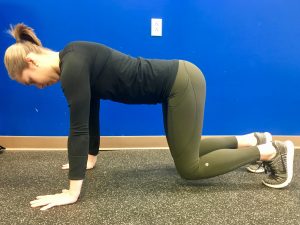
2. Side Plank – Support your weight with your elbow and your knees stacked on top of one another. Lift your hips to an angle which forms a straight line from your shoulder to your knees. Keep your head in line with the midline of your body and keep your chin tucked. Complete 5-10 breath cycles while holding this position.
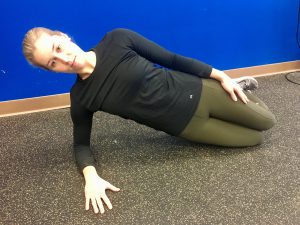
3. Sustained Squat – Perform a squat by lowering your body from your hips. Maintain this body position while making sure your knees do not pass the front of the toes, keeping a straight spine, and reaching your arms overhead with your hands open. Hold this position for 5-10 breath cycles.
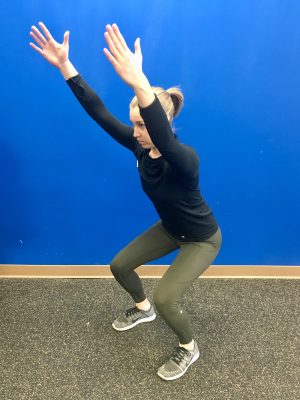
4. Physioball Holds Level 1 – Hold a physioball between your hands and knees. Make sure to maintain your head in a chin tucked position, your lower spine flat against the ground, and your feet above the level of your knees. Hold this position for 5-10 breath cycles.
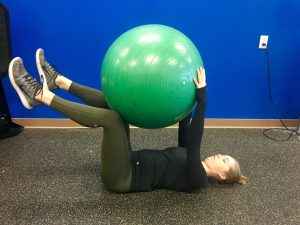
5. Physioball Holds Level 2 – Attain physioball hold level 1 position. While holding this position, remove opposite arm and leg from the ball at a height well above the ground. Hold this position for 5-10 breath cycles during each hold. Alternate between sides.
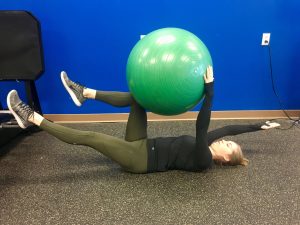
Select an Exercise that You Enjoy
There are countless ways in which to exercise. Above all, it is suggested to complete exercise that you enjoy. If you find a particular type of exercise that you enjoy, it will be much easier to prioritize completion of regular weekly exercise. Why should you force yourself to complete exercise that you hate when you have so many options? Here are a few popular exercise types to consider:
1. Machines
2. Free Weights
3. Plyometrics
4. Running or Elliptical
5. Cycling
6. Sport Participation
7. Yoga
Cool Down
The cool down functions exactly opposite to the warm up. Compared to a warm up, where the goal is to increase your body’s temperature, heart rate, respiration, and blood flow, a cool down is designed to reduce your body’s heart rate and respiration following a workout. As long as the cool down consists of providing gradual rest and relaxation to your body, it can be designed to your needs. A time period from 5 minutes to 15 minutes is recommended to cool down your body. Some examples include walking or low intensity stretching.
Exercising Schedule
The World Health Organization recommends that adults aged 18–64 should do at least 150 minutes or 2.5 hours of moderate-intensity aerobic physical activity throughout the week.1 One way to distribute these minutes is 30 minutes per day 5x per week. No matter how you choose to distribute these minutes, find a schedule that you enjoy and that works with your lifestyle.
If you would like to learn more from an Athletico physical therapist, please use the button below to request an appointment!
The Athletico blog is an educational resource written by Athletico employees. Athletico bloggers are licensed professionals who abide by the code of ethics outlined by their respective professional associations. The content published in blog posts represents the opinion of the individual author based on their expertise and experience. The content provided in this blog is for informational purposes only, does not constitute medical advice and should not be relied on for making personal health decisions.
Resources
1. World Health Organization (2010). Global Recommendations on Physical Activity for Health. Retrieved from https://www.who.int/dietphysicalactivity/publications/9789241599979/ en/
2. Beaechle T.R., and Earle R.W. (2008). Essentials of Strength Training and Conditioning (3rd ed.). Champaign, IL: National Strength and Conditioning Association.
3. Bessman, S.P., and F. Savabi. The role of phosphocreatine energy shuttle in exercise and muscle hypertrophy. In: Biochemistry of Exercise VII, A.W. Taylor. P.D. Gollnick, H.J. Green,
C.D. Ianuzzo, E.G. Noble, G. Metivier, and J.R. Sutton, eds. Champaign, IL: Human Kinetics. 1990. pp. 167-177
4. Coburn, W.C., and Malek, M.H., (2012). NSCA’s Essentials of Personal Training (2nd ed.). National Strength and Conditioning Association.
5. Frank, Clare et al., (2013). Dynamic Neuromuscular Stabilization & Sports Rehabilitation.
International Journal of Sports Physical Therapy, 8(1). pg. 62-73.
